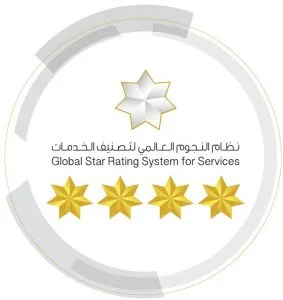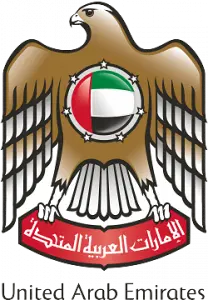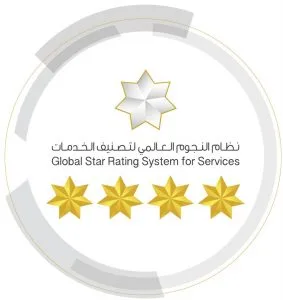Preface
ICA is a Federal building that attained 2-Pearl Rating as a Green Building, awarded by Estidama, the division of Abu Dhabi Urban Planning Council responsible for enforcing and supervising the sustainable development of new buildings in Abu Dhabi.
Objective
ICA is a Federal building that attained 2-Pearl Rating as a Green Building, awarded by Estidama, the division of Abu Dhabi Urban Planning Council responsible for enforcing and supervising the sustainable development of new buildings in Abu Dhabi.
This Handbook aims to provide you, ICA employees, with the necessary information about your building in order for you to appreciate the advantages that you will enjoy when being in a green building.
The Handbook aims to keep you proudly involved in maintaining the efficiency of the building and explains your user responsibilities towards the environment and to sustain the superior performance of the building for your well being.
What is a green building
A green building is a building that is designed and constructed in a way that has the least possible impact on our environment. A building that:
- Provides a safe and healthy environment to occupants with no harmful emissions, controllable comfort, and rich supply of fresh air and daylight.
- Consumes less energy through using the most up-to-date technology in energy efficiency.
- Saves precious water through reducing waste and improving pure water quality.
- Recycles waste water and collects rain water to be used for irrigation
- Does not use harmful materials and produces less waste.
- Is intelligent and interactive with occupants.
It is important to know that:
- Green buildings are better than regular buildings
- Not all green buildings are equal in performance, efficiency and quality. This manual will tell you how the healthy facility is designed to perform and where it is achieving superior performance and delivering improved quality. See 1.4 below for performance information that is specific to ICA project.
- A green building DOES NOT remain green unless you, the occupants and operators cooperate together in using and maintaining the building the way it is intended to be.
- The Building is intelligent enough to keep you informed about its day to day performance and what quality of indoor environment you are living in. It also tells you how efficient you are operating it and whether there are issues that need your attention to keep the building healthy and efficient. (See Occupant Feedback below for details).
How green is ICA- HQ&SPB.
ICA Headquarters and Service Point Building is rated as 2 -Pearl rating according to Estidama Pearl Rating System. This means it is higher in performance and quality than all non-rated buildings.The building has achieved the following key performance indicators for which it was awarded the 2-Pearl rating:
- Indoor air quality has Carbon Dioxide concentration less than 1000 ppm. This means the air you breathe is as close as possible to outside fresh air with no smoke, smells or harmful gases.
- Indoor air is being filtered through MERV 9 filtration which is a high efficiency fine filter that removes all dust and particles from the air stream.
- The building consumes 80% of electric power energy when compared to a standard base building.
- The building consumes 70% of potable water when compared to a standard base building.
- The building has 40% of shaded car parking spaces and open garden spaces which provides cooler space outside that enables you to enjoy pleasant break outs and outdoor activities.
- Individually controlled room temperature in every room
- Waste management and recycling strategy to enable reduced waste and waste segregation.
ICA looks to your efforts in order to keep an eye on these figures and promote the awareness among your colleagues to promote environmental awareness and conservation of power, water, and natural resources.
Benefits of being in a green building
Working in ICA, you will enjoy a lot of advantages including the following:
Water is the most precious natural resource that is vital to sustaining the life of humans, animals and plants. Water is scarce in the United Arab Emirates being a desert land with no rivers, saline wells and 20 mm of annual rain fall. This makes it essential for any sustainable design to conserve water. Potable water in UAE is mostly produced through desalination of sea water. This makes conserving potable water is also conserving energy and reducing carbon emission and pollution
We are implementing a state of the art homogeneous engineering design in landscape and irrigation design to choose the most useful plants and the least in water consumption. However most water efficient irrigation system do not maintain their efficiency during operation due to misuse, physical damage to irrigation pipes, poor maintenance, and manual gardener intervention.
In order to maintain the system running as efficient as planned, water monitoring and alarm reporting system should be included within the Building Management System.
- Around 90 % of ICA connected electric loads are monitored through a network of smart meters independent of ADDC meters. ICA-consumed energy is monitored on all equipment, all small power DBs, and all lighting DBs are through a separate smart meter. Power consumption in building is also monitored through a common meter. All HVAC equipment is individually monitored through smart meters on MCC. All smart meters are connected to central BMS. Energy Management and monitoring system shall be added to the BMS workstation with the necessary programming, customization and training to enable the BMS operators to follow the energy consumption and generate corrective action and performance reports as necessary. The central energy monitoring system will store the historical data for presentation to Estidama upon request.
- Healthy indoor air that is smoke-free, germ-free and the air-conditioning system will not spread germs from one sick occupant to the rest of the occupants. You will be less frequently falling sick of airborne diseases like cold and flu that is the main reason for sickness in offices.
- Your indoor relative humidity is maintained within comfort levels so it does not promote fungus growth and Asthma /Allergy problems as the case in other “sick buildings”.
- The materials used in the building construction are free of Asbestos, Chlorine, toxic odors, solvents and volatile organic compounds (VOC), Formaldehydes and other indoor pollutants that affect human well-being and general health. It has been the industry’s drive in the past decades to develop adhesives, sealants, painting and coatings that have stronger mechanical bonding and ability to adhere to different materials in different ways. No attention was given to how harmful were the emission of solvents and other VOCs released from these adhesives on human heath that continues for years after the initial drying of the material. VOCs are harmful to the health and well being of building occupants and should be avoided in all sustainable buildings.
The following have been specified to comply with free VOC :
- Interior Adhesives
- Tile fixing
- Carpet fixing
- Wallpaper fixing
- Interior Sealants
- Structural Glazing adhesives and sealants
- Interior Painting
- Gypsum Board false ceilings
- Gypsum tiles lay-in Ceilings
- Aluminum tiled or strip false ceiling
Formaldehyde is one of the most commonly known indoor pollutants that are emitted from numerous materials used in indoor finishes
A general requirement is provided in the specification “All internal construction materials shall meet formaldehyde class E1” .
The timber and composite wood products used on the project, including temporary construction timber, is reused OR certified (with Chain of Custody Certification: CoC) under any one or any combination of the following certification schemes as per the Requirement Achievement table: Forest Stewardship Council (FSC), or Program for the Endorsement of Forest Certification scheme (PEFC) or the following national schemes endorsed by PEFC: the Canadian Standards Association, CSA, the Sustainable Forestry Initiative SFI and the Malaysian Timber Certification Scheme MTCS; And All timber is legally sourced and not on the CITES (Convention on International Trade in Endangered Species) list of endangered species (Appendix I, II and III).
Operational Waste Management
In terms of operational waste management, our team will seek ways to facilitate the reduction of waste generated by building occupants and disposed of in landfills. We will encourage the provision of easily accessible waste areas for both building staff and waste disposal collection. This collection area will allow for the pre-separation of recycling materials, including paper, cardboard, glass, plastics and metals. We maintain 3 color-coded bins, End users would segregate and dispose their waste in the nearby waste room, then the facility management would empty the bins after working hours.
- Green Containers for plastics, glass and metals
- Blue Containers for papers and cardboards
- Black Containers for non- recyclable and
non-compostable waste.
When the new trees grow they will have large shading canopies providing a shaded and spacious outdoor area to allow employees to walk to the center through nicely shaded walkways.
Moreover, bicycles Parking spaces very close to the gate.
What should you do
In order for you to continue enjoying the above benefits you will be expected to participate in our team effort in keeping the building perform as planned and avoiding the common misuse that result in building deterioration and loss of quality.
Here are some basic precautions that you should keep in mind and promote to others:
- Do not waste precious water. Use the 1/2 flush button when a full flush is not necessary, do not keep the water running when you are not actually using it.
- All hand wash mixers are self-closing type with 1.9 l/min flow regulator.
- Report any water leakage as soon as you see it, even if it is few droplets, these droplets can save a life elsewhere in the world.
- Use wasteful resources wisely such as disposable plastics.
- Segregate the waste prior to disposal in color-coded bags and place each bag into the corresponding bin as the green containers for plastics and metals , blue containers for papers and cardboards, Black containers for non-recyclable and non-compostable waste
- Observe the colors of waste bins and segregate waste as you dispose. Recycle if you can to reduce waste.
- Participate in environmental awareness activities to get to know more about ways you can save the environment.
- Encourage your junior staff to be environmentally cautious and suggest incentive plans for those acting responsibly.
- Use low energy installations to maximize the building performance.
These are a few issues and we look forward to your initiatives to add new suggestions to this list that will be published in the next issue.




Rate your experience